With its diverse wetlands, lakes, and coastal habitats, Maine is home to an impressive array of 23 duck species, each contributing to the region’s ecological richness.
From the iconic Mallard and the striking Tufted Duck to the enigmatic Steller’s Eider and the versatile Long-tailed Duck, these waterfowl paint a vibrant tapestry of biodiversity across the state.
This exploration delves into the distinctive characteristics, behaviors, and conservation needs of these 23 duck species in Maine.
From the common and adaptable to the rare and vulnerable, each duck species plays a vital role in maintaining the ecological balance of Maine’s aquatic environments. Let’s get started.
24 Ducks in Maine
Through this journey, we will delve into the distinctive characteristics, lifestyles, and conservation needs of these 23 ducks, shedding light on the importance of preserving their habitats for the continued well-being of Maine’s diverse waterfowl populations.
Join us as we unravel the stories behind each quack and feather, showcasing the beauty and significance of these ducks in the picturesque landscapes of Maine.
1. Mallard

- Scientific name: Anas platyrhynchos
- Population: Abundant, widespread
- Life span: 5-10 years
- Size: 20-26 inches
- Weight: 2-3 pounds
- Food: Omnivorous diet, includes aquatic plants, insects, and small fish
- Status: Least Concern (IUCN)
The Mallard, known for its distinctive iridescent green head and white neck ring, is the most recognizable duck in Maine.
Found in various habitats, from ponds to marshes, Mallards are highly adaptable. Their omnivorous diet and ability to thrive in diverse environments contribute to their abundant population.
Mallards lead a dynamic lifestyle, often forming pairs during the breeding season. Their nests are usually constructed on the ground, hidden amidst vegetation.
After hatching, ducklings follow their mother to water, where they learn to forage and avoid predators. Mallards are migratory, with some populations staying year-round in Maine while others migrate south during winter.
These ducks exhibit social behavior, often seen in large flocks. Mallards are visually striking and play a crucial role in maintaining ecological balance through their foraging habits.
2. American Black Duck
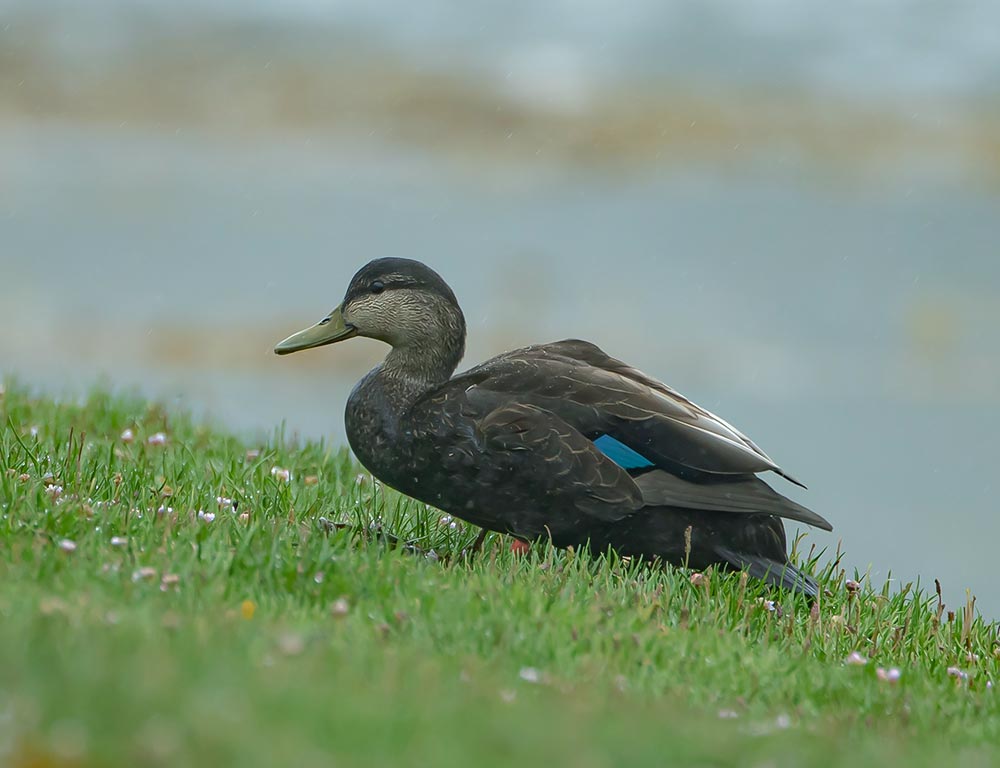
- Scientific name: Anas rubripes
- Population: Stable, moderate
- Life span: 15 years
- Size: 20-24 inches
- Weight: 1.5-2.5 pounds
- Food: Aquatic plants, invertebrates, seeds
- Status: Least Concern (IUCN)
The American Black Duck, a close relative of the Mallard, has a more subdued appearance with uniformly dark brown plumage.
Common in Maine’s wetlands, these ducks prefer freshwater habitats, where they forage for aquatic plants, invertebrates, and seeds. American Black Ducks lead a relatively quiet lifestyle, often seen in pairs or small family groups.
Their nests, situated on the ground and concealed in vegetation, provide protection for eggs and ducklings. Migratory in nature, some populations undertake long journeys between breeding and wintering grounds.
These ducks are vital indicators of wetland health. Conservation efforts in Maine focus on preserving the habitats crucial for American Black Ducks, ensuring the continued stability of their population.
3. Green-winged Teal
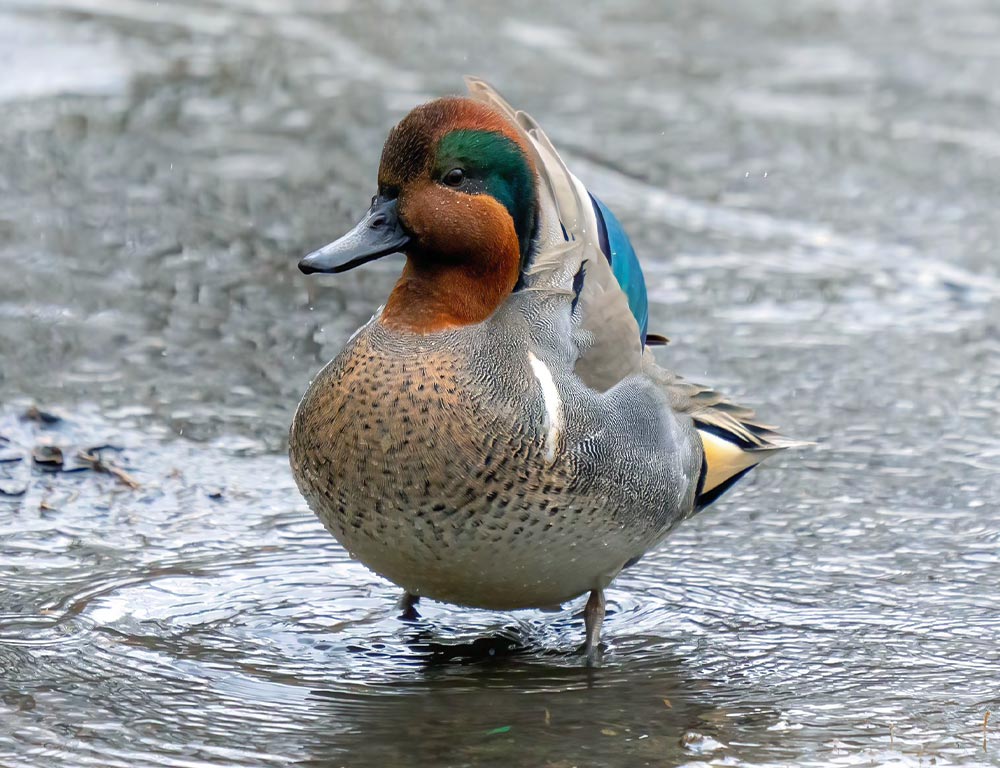
- Scientific name: Anas crecca
- Population: Stable, common
- Life span: 5-10 years
- Size: 12-16 inches
- Weight: 0.5-1 pound
- Food: Aquatic invertebrates, seeds, plants
- Status: Least Concern (IUCN)
The Green-winged Teal, characterized by its distinctive green wing patch, is a small dabbling duck found in various wetlands across Maine. Their compact size and agile nature make them excellent fliers and divers.
Green-winged Teals exhibit a nomadic lifestyle, often changing feeding locations in response to food availability.
During the breeding season, they form monogamous pairs and build nests on the ground, hidden in tall vegetation. With short migrations, some populations remain in Maine year-round, while others move south for winter.
These ducks play a crucial role in controlling insect populations and dispersing seeds. Conservation efforts aim to protect the diverse wetland habitats essential for the Green-winged Teal’s survival.
4. Blue-winged Teal
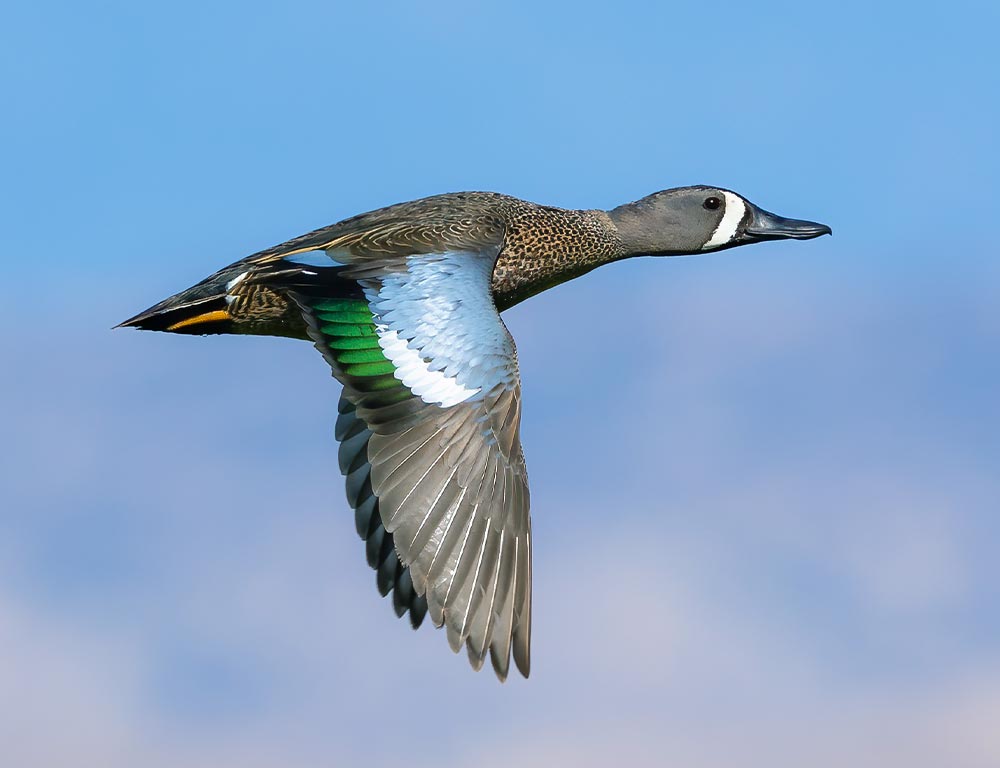
- Scientific name: Anas discors
- Population: Stable, common
- Life span: 5-10 years
- Size: 14-16 inches
- Weight: 0.5-1 pound
- Food: Aquatic invertebrates, seeds, plants
- Status: Least Concern (IUCN)
The Blue-winged Teal, with its striking blue and white wing markings, is a migratory duck commonly found in Maine’s wetlands. These ducks exhibit vibrant breeding plumage during the mating season, making them easily distinguishable.
Blue-winged Teals follow a dynamic lifestyle, often forming loose colonies during the breeding season. Their nests, typically situated on the ground in grassy areas, provide a secure environment for eggs and ducklings.
Migratory in nature, these ducks travel between their breeding grounds in Maine and wintering areas in the southern United States and Central America.
These agile dabbling ducks contribute to ecosystem balance by foraging on aquatic invertebrates and dispersing seeds. Conservation initiatives focus on preserving the habitats crucial for Blue-winged Teal breeding and migration.
5. Wood Duck
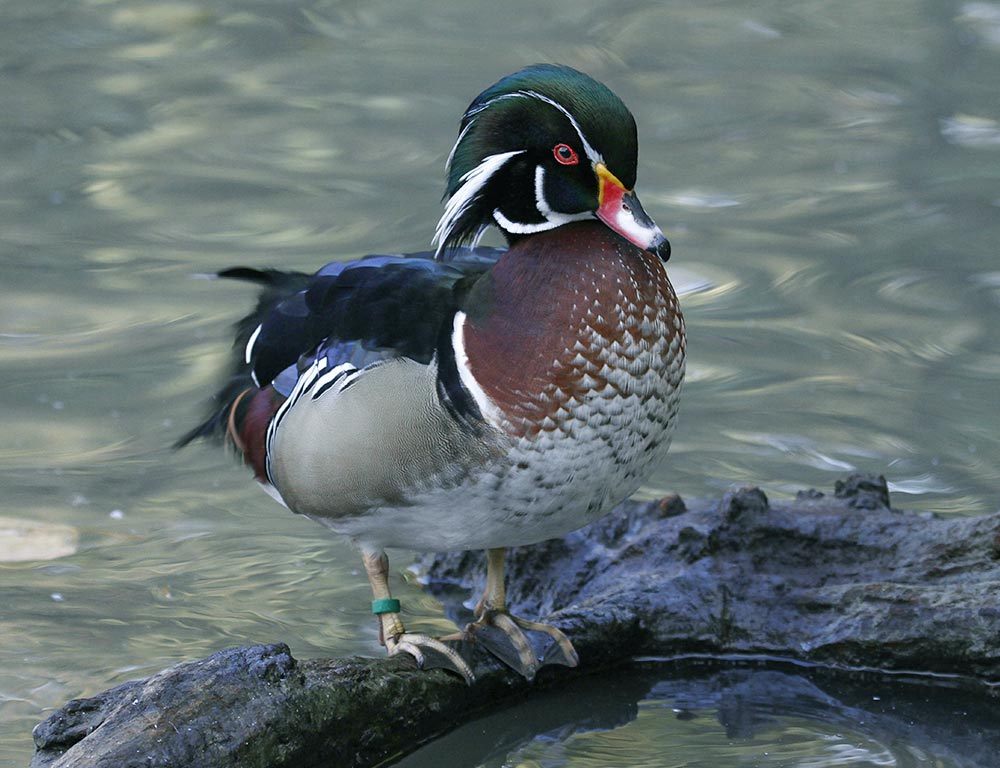
- Scientific name: Aix sponsa
- Population: Increasing, stable
- Life span: 5-10 years
- Size: 17-21 inches
- Weight: 1-1.5 pounds
- Food: Aquatic invertebrates, seeds, acorns
- Status: Least Concern (IUCN)
The Wood Duck, renowned for its vibrant and elaborate plumage, is a distinctive species found in wooded wetlands and freshwater habitats across Maine.
Recognized for their striking iridescence and intricate patterns, Wood Ducks are a delight to birdwatchers.
Wood Ducks lead a somewhat solitary lifestyle, often seen in pairs or small family groups. They are cavity nesters, using natural tree hollows or man-made nest boxes.
The young ducklings are precocial and quickly learn to forage for aquatic invertebrates and seeds. Conservation efforts have contributed to the increasing population of Wood Ducks in Maine.
Habitat preservation, including the provision of suitable nesting sites, is crucial for ensuring the continued success of these visually stunning ducks in the region.
5. Northern Shoveler
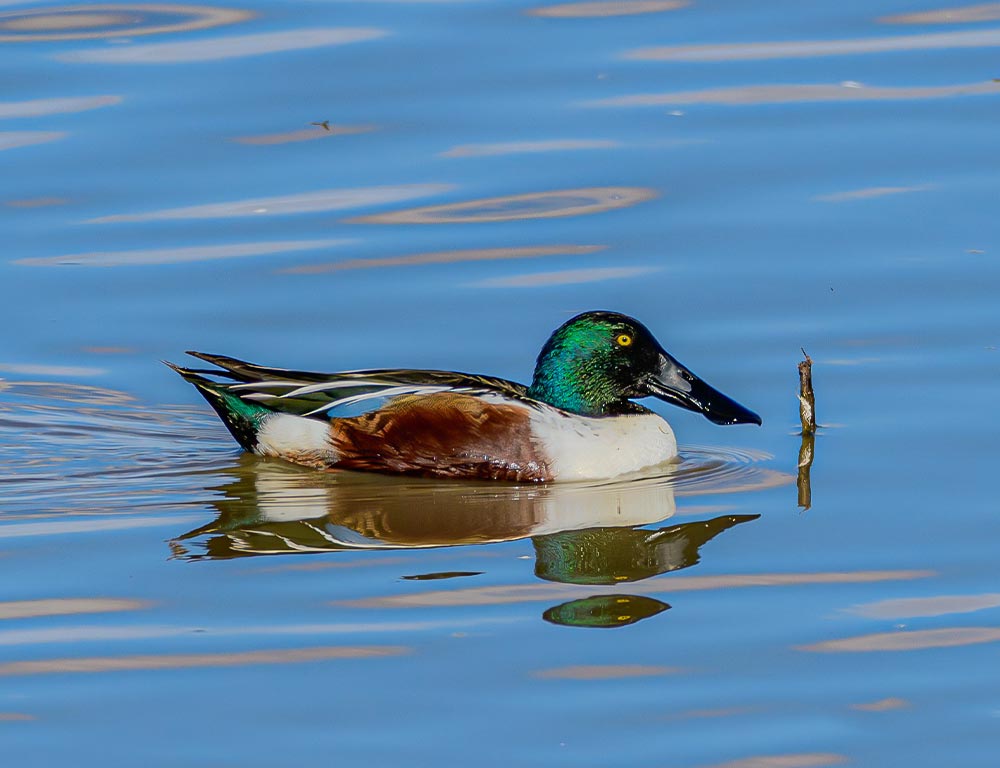
- Scientific name: Anas clypeata
- Population: Stable, widespread
- Life span: 5-10 years
- Size: 18-22 inches
- Weight: 1-2 pounds
- Food: Aquatic invertebrates, seeds, plants
- Status: Least Concern (IUCN)
The Northern Shoveler, named for its distinctive spatula-shaped bill, is a dabbling duck commonly found in wetlands and ponds throughout Maine. This duck stands out among waterfowl with its striking breeding plumage and unique feeding behaviour.
Northern Shovelers exhibit a dynamic lifestyle, often foraging in shallow water with their bills submerged to filter out aquatic invertebrates and seeds.
During the breeding season, males display vibrant plumage to attract mates. Nests are typically concealed on the ground amidst tall vegetation.
These ducks are vital for wetland ecosystems, contributing to nutrient cycling and controlling insect populations. Conservation efforts aim to protect their habitats and ensure the continued stability of Northern Shoveler populations in Maine.
6. Northern Pintail
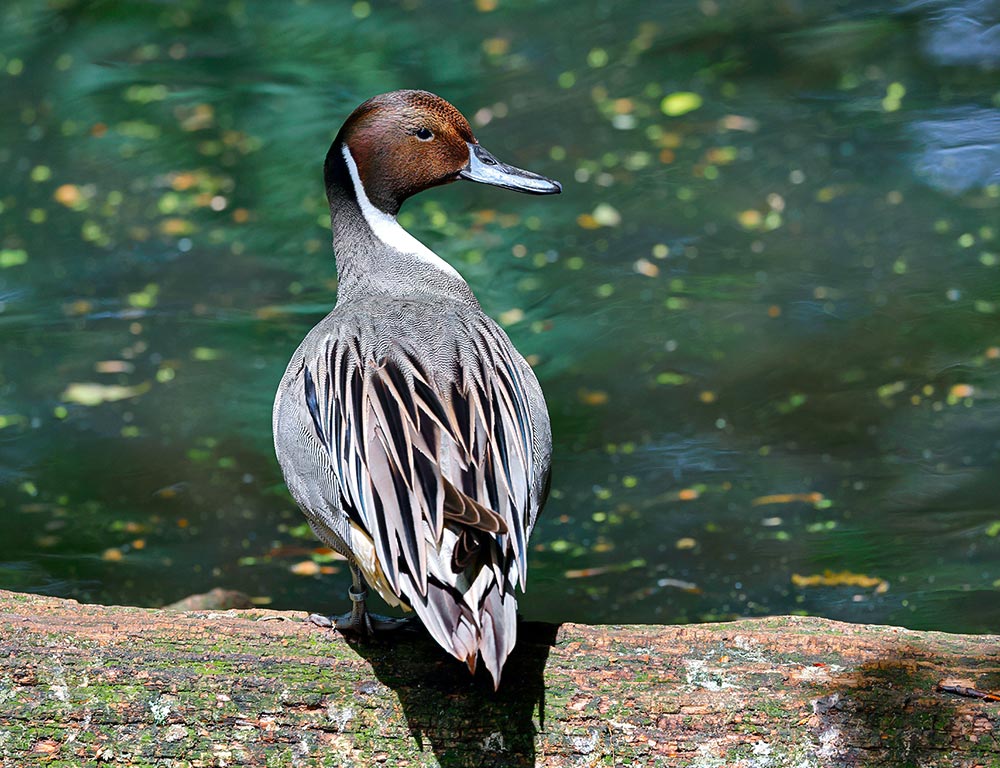
- Scientific name: Anas acuta
- Population: Stable, moderate
- Life span: 5-10 years
- Size: 20-30 inches
- Weight: 1.5-2.5 pounds
- Food: Aquatic invertebrates, seeds, plants
- Status: Least Concern (IUCN)
The Northern Pintail, recognized for its elegant and slender appearance, is a migratory duck found in various wetland habitats across Maine. This species is easily identifiable With its long neck and pointed tail.
Northern Pintails lead a nomadic lifestyle, moving between breeding and wintering grounds.
During the breeding season, they form monogamous pairs, and nests are constructed on the ground, usually concealed in tall vegetation. These ducks are strong fliers and cover significant distances during migration.
Their foraging habits, primarily focused on aquatic invertebrates and seeds, contribute to the ecological balance of wetland ecosystems. Conservation initiatives aim to safeguard the diverse habitats essential for Northern Pintail breeding and migration.
7. Gadwall
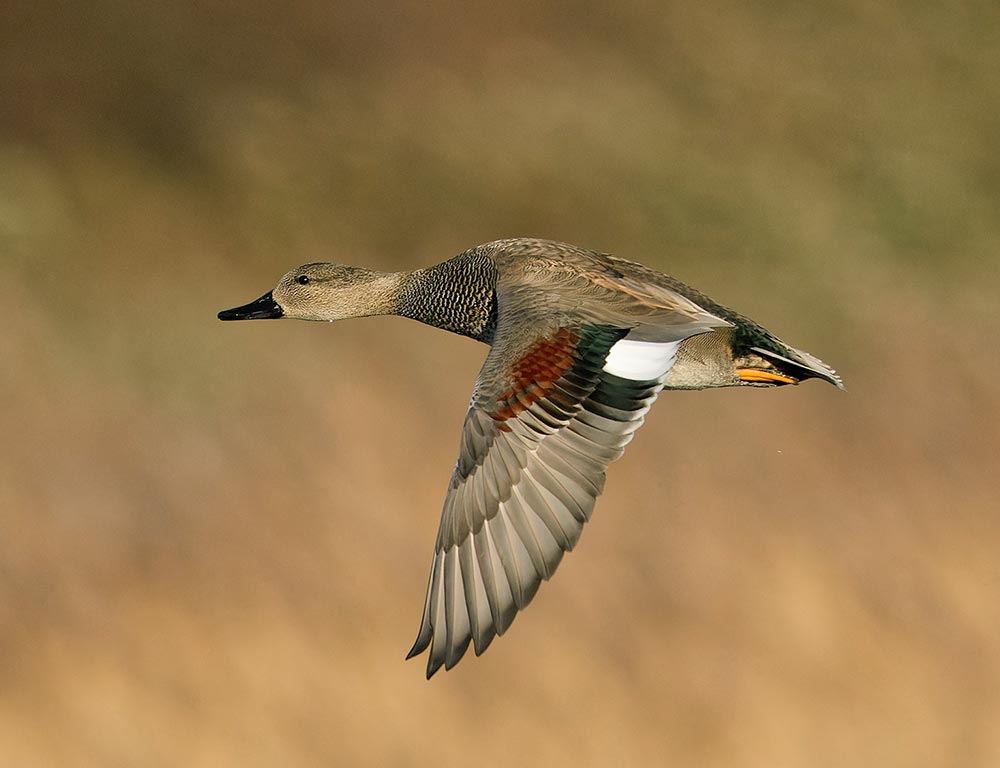
- Scientific name: Anas strepera
- Population: Stable, common
- Life span: 5-10 years
- Size: 18-23 inches
- Weight: 1.5-2.5 pounds
- Food: Aquatic invertebrates, seeds, plants
- Status: Least Concern (IUCN)
The Gadwall, with its mottled brown plumage and distinctive white speculum, is a dabbling duck prevalent in Maine’s wetlands and lakes.
Known for their subtle beauty, Gadwalls are often found in mixed flocks with other waterfowl species. Gadwalls exhibit a flexible lifestyle, adapting to a variety of wetland habitats.
During the breeding season, they construct nests on the ground, concealed in tall vegetation. These ducks are social and often forage in groups, utilizing their broad bills to feed on aquatic invertebrates and seeds.
Their stable population and adaptability make Gadwalls important contributors to wetland ecosystems. Conservation efforts focus on preserving the habitats necessary for breeding, foraging, and wintering.
8. European Wigeon

- Scientific name: Anas penelope
- Population: Stable, occasional
- Life span: 5-10 years
- Size: 16-21 inches
- Weight: 1-2 pounds
- Food: Aquatic invertebrates, seeds, plants
- Status: Least Concern (IUCN)
The European Wigeon, although not native to North America, is an occasional visitor to Maine’s coastal areas and wetlands. Recognized for its unique head markings and soft whistling calls, the European Wigeon adds diversity to waterfowl populations.
European Wigeons exhibit a migratory lifestyle, travelling long distances between their breeding grounds in northern Europe and wintering areas.
They often join mixed flocks of other dabbling ducks during their stay in Maine. Nests are typically constructed on the ground in concealed locations.
While not as common as some native species, European Wigeons contribute to the rich biodiversity of waterfowl in the region.
Conservation efforts in Maine focus on protecting habitats that support a variety of duck species, including occasional visitors like the European Wigeon.
9. American Wigeon
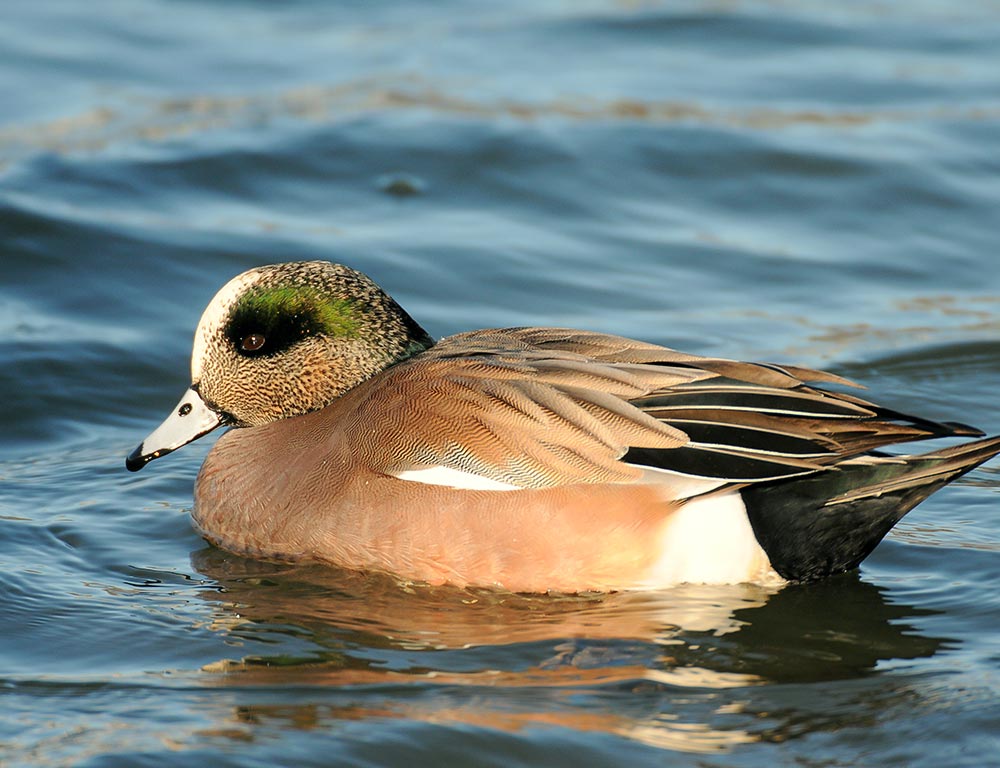
- Scientific name: Mareca americana
- Population: Stable, common
- Life span: 5-10 years
- Size: 17-23 inches
- Weight: 1-2 pounds
- Food: Aquatic invertebrates, seeds, plants
- Status: Least Concern (IUCN)
The American Wigeon, recognized for its distinctive white crown and green eye patch, is a dabbling duck commonly found in wetlands and ponds across Maine.
With its elegant and colourful plumage, this species is a captivating presence among waterfowl. American Wigeons exhibit a flexible lifestyle, often foraging in shallow water and grazing on grasses in upland areas.
During the breeding season, they form monogamous pairs, and nests are constructed on the ground and concealed in vegetation. These ducks are social and often seen in mixed flocks with other dabbling ducks.
Their adaptability to various habitats and feeding habits make American Wigeons important contributors to wetland ecosystems.
Conservation efforts in Maine focus on protecting the diverse habitats necessary for their breeding, foraging, and wintering activities.
10. Fulvous Whistling Duck
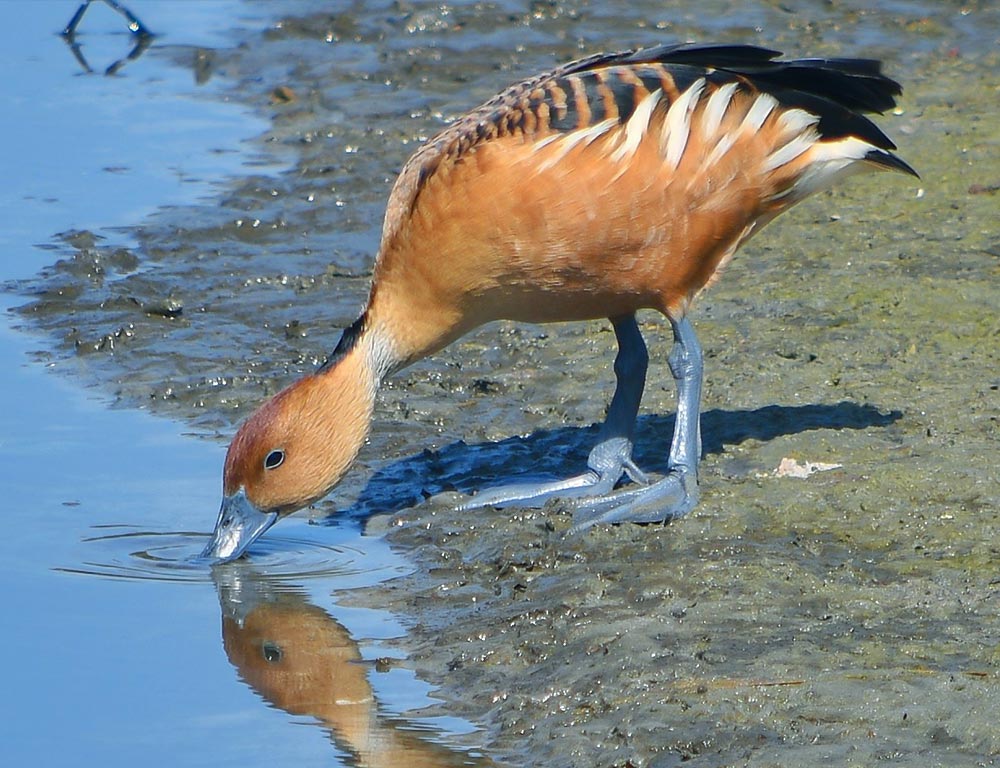
- Scientific name: Dendrocygna bicolor
- Population: Stable, occasional
- Life span: 5-10 years
- Size: 18-22 inches
- Weight: 1-2 pounds
- Food: Aquatic invertebrates, seeds, plants
- Status: Least Concern (IUCN)
The Fulvous Whistling Duck occasionally visits Maine’s wetlands with its distinctive reddish-brown plumage and unique whistling calls. Recognized for its striking appearance, this duck adds a tropical touch to the waterfowl diversity in the region.
Fulvous Whistling Ducks exhibit a migratory lifestyle, travelling between their breeding grounds in the southern United States and wintering areas.
Nests are typically built on the ground, concealed in vegetation. These ducks often forage in shallow water, using their specialized bills to filter out aquatic invertebrates and seeds.
While not as common as some native species, Fulvous Whistling Ducks contribute to the rich biodiversity of waterfowl in the region.
Conservation efforts in Maine aim to protect habitats supporting various duck species, including occasional visitors like the Fulvous Whistling Duck.
11. Canvasback
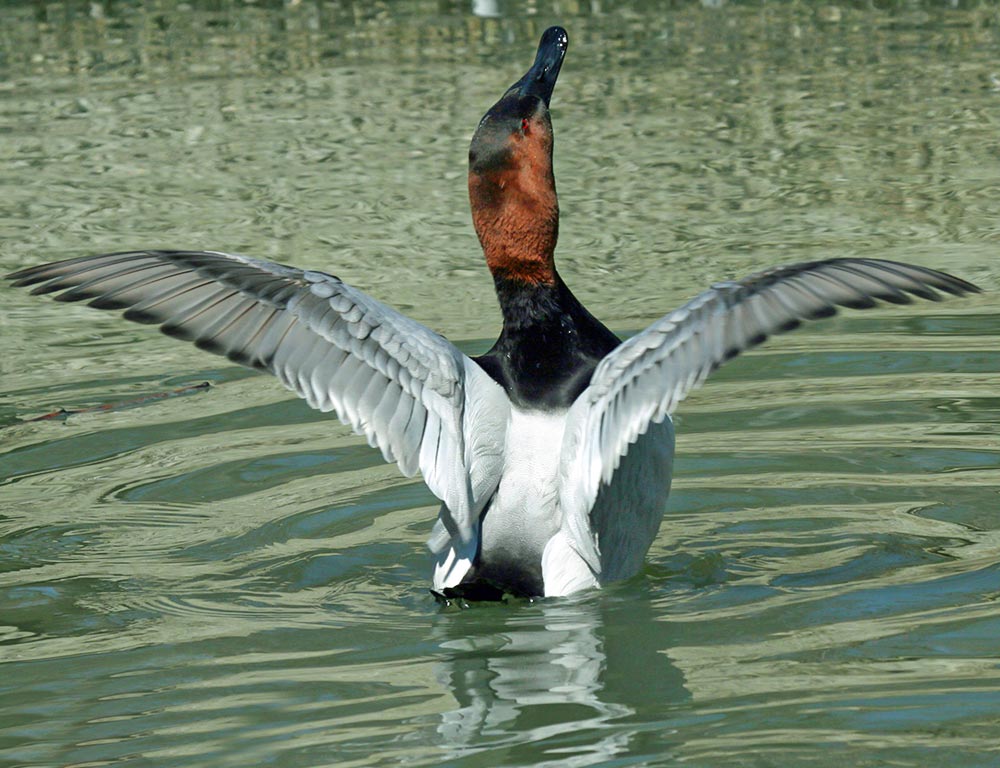
- Scientific name: Aythya valisineria
- Population: Stable, moderate
- Life span: 10-15 years
- Size: 19-22 inches
- Weight: 2-3 pounds
- Food: Aquatic plants, mollusks, invertebrates
- Status: Least Concern (IUCN)
The Canvasback, known for its striking redhead and sleek profile, is a diving duck commonly found in large lakes and rivers across Maine.
With its unique feeding habits and distinctive appearance, this species is a notable member of the waterfowl community. Canvasbacks lead a relatively solitary lifestyle, often foraging in deeper water than dabbling ducks.
Their diet includes aquatic plants, mollusks, and invertebrates. During the breeding season, they form monogamous pairs, and nests, usually hidden in tall vegetation, are constructed on the ground.
These ducks are strong fliers and undertake significant migrations between their breeding and wintering grounds. Conservation initiatives focus on protecting the diverse habitats essential for Canvasback breeding and foraging activities.
12. Redhead
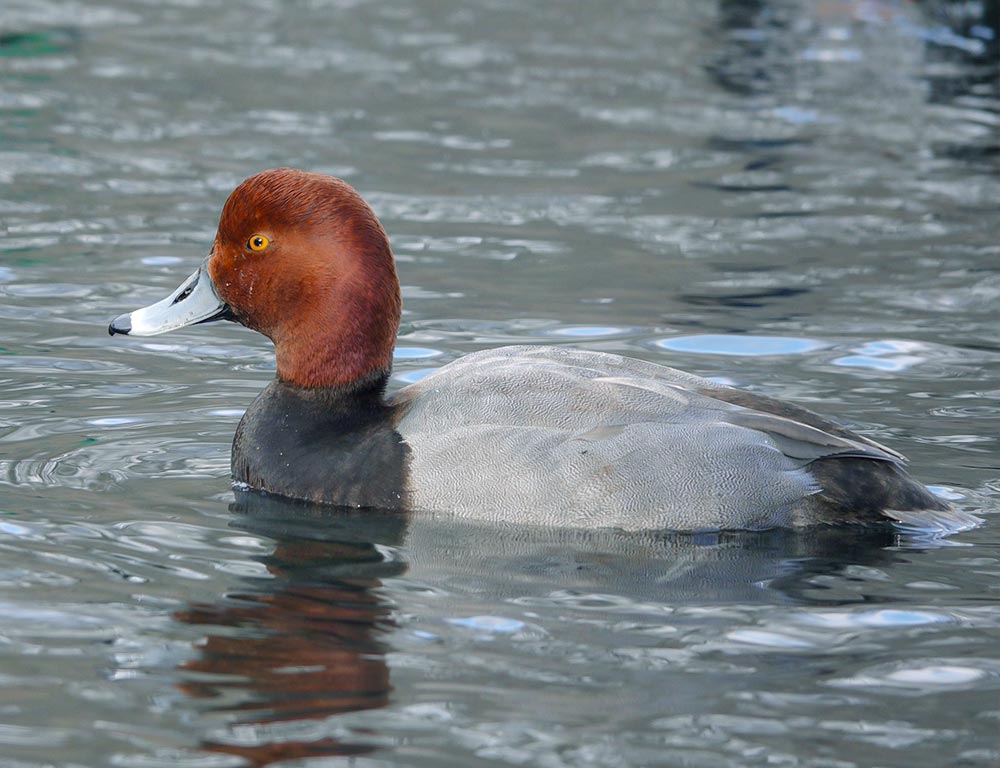
- Scientific name: Aythya americana
- Population: Stable, moderate
- Life span: 10-15 years
- Size: 16-22 inches
- Weight: 1.5-3 pounds
- Food: Aquatic plants, invertebrates, seeds
- Status: Least Concern (IUCN)
The Redhead, distinguished by its bright red head and gray body, is a diving duck commonly found in freshwater lakes and ponds across Maine.
With its striking appearance and distinctive vocalizations, this species is a prominent member of the waterfowl community. Redheads lead a dynamic lifestyle, often forming large flocks during the winter months.
Their diet includes aquatic plants, invertebrates, and seeds. During the breeding season, they form monogamous pairs, and nests, usually hidden in tall vegetation, are constructed on the ground.
These ducks are known for their strong flying abilities and undertake significant migrations. Conservation efforts aim to protect the diverse habitats crucial for Redhead breeding and foraging activities.
13. Ring-necked Duck
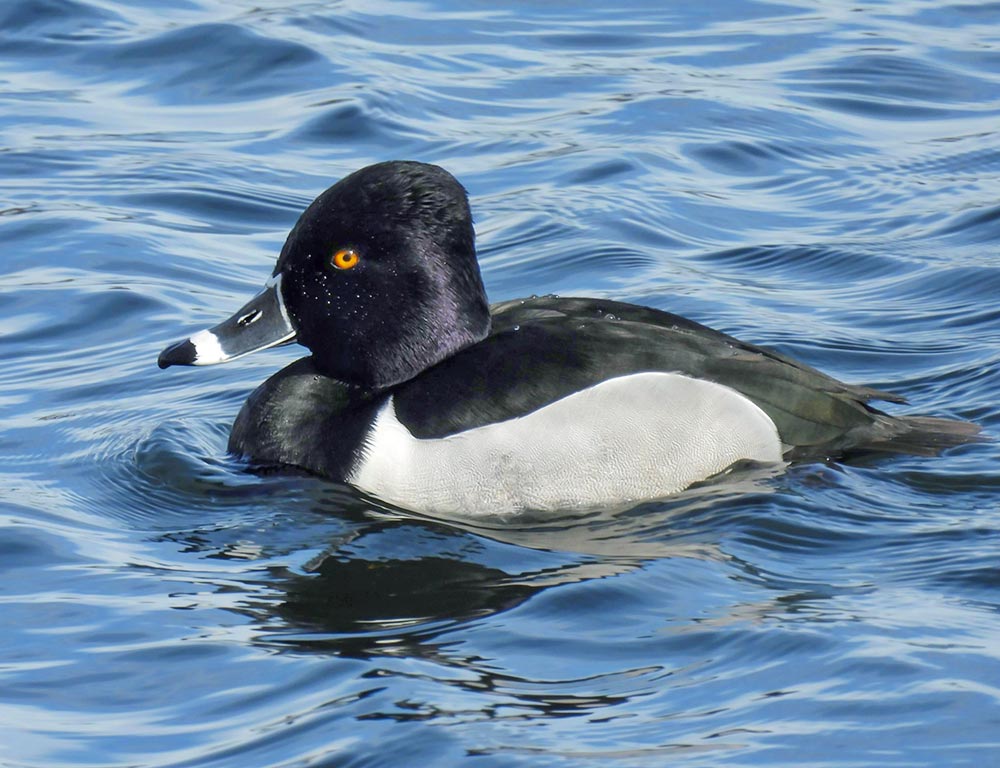
- Scientific name: Aythya collaris
- Population: Stable, common
- Life span: 10-15 years
- Size: 14-18 inches
- Weight: 1-2 pounds
- Food: Aquatic invertebrates, seeds, plants
- Status: Least Concern (IUCN)
The Ring-necked Duck, named for the faint chestnut ring around its neck, is a diving duck commonly found in freshwater lakes and ponds across Maine.
This species adds diversity to the waterfowl community with its distinctive markings and energetic diving behaviour.
Ring-necked Ducks exhibit a dynamic lifestyle, often foraging in deeper water than dabbling ducks. Their diet includes aquatic invertebrates, seeds, and plants.
During the breeding season, they form monogamous pairs, and nests, usually hidden in tall vegetation, are constructed on the ground.
These ducks are known for their strong flying abilities and undertake significant migrations. Conservation initiatives focus on protecting the diverse habitats essential for Ring-necked Duck breeding and foraging activities.
14. Tufted Duck
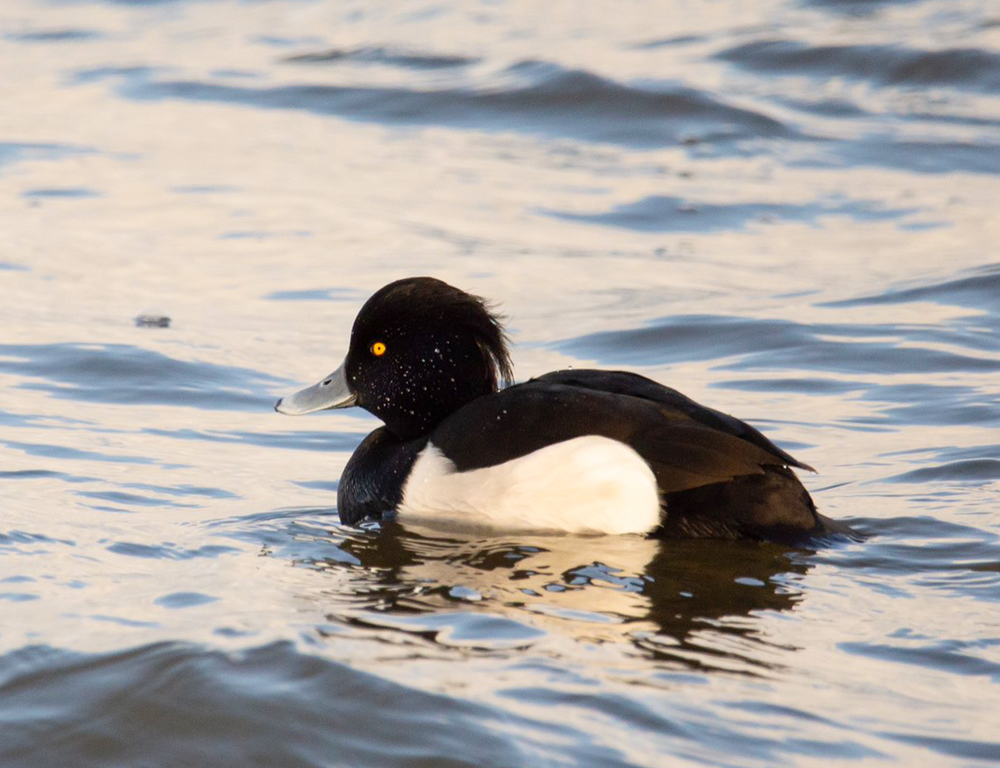
- Scientific name: Aythya fuligula
- Population: Stable, common
- Life span: 10-15 years
- Size: 16-20 inches
- Weight: 1-2 pounds
- Food: Aquatic invertebrates, seeds, plants
- Status: Least Concern (IUCN)
The Tufted Duck, known for the striking tuft on the back of its head, is a diving duck commonly found in freshwater lakes and ponds across Maine. With its sleek black and white plumage, this species is a distinctive member of the waterfowl community.
Tufted Ducks exhibit a dynamic lifestyle, often diving for aquatic invertebrates, seeds, and plants in deeper waters. They form loose flocks during migration and winter months.
During the breeding season, they form monogamous pairs, and nests are constructed on the ground, hidden in vegetation.
These ducks are known for their strong flying abilities and undertake significant migrations. Conservation efforts aim to protect the diverse habitats crucial for Tufted Duck breeding and foraging activities.
15. Greater Scaup
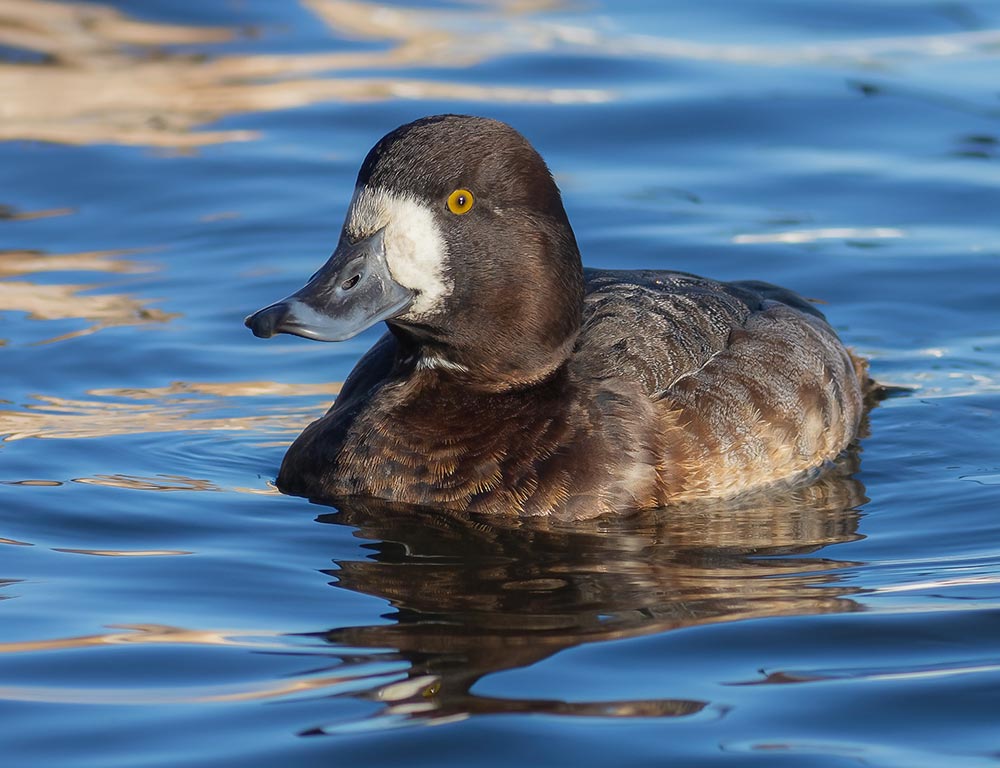
- Scientific name: Aythya marila
- Population: Stable, common
- Life span: 10-15 years
- Size: 16-20 inches
- Weight: 2-3 pounds
- Food: Aquatic invertebrates, mollusks, seeds
- Status: Least Concern (IUCN)
The Greater Scaup, distinguished by its striking blue bill and dark plumage, is a diving duck commonly found in coastal waters and larger lakes across Maine.
With its energetic diving behaviour and distinct vocalizations, this species is a notable member of the waterfowl community.
Greater Scaups exhibit a dynamic lifestyle, diving for aquatic invertebrates, mollusks, and seeds in deeper waters.
They form large flocks during migration and winter months. During the breeding season, they form monogamous pairs, and nests are constructed on the ground, hidden in vegetation.
These ducks are strong fliers and undertake significant migrations. Conservation initiatives focus on protecting the diverse coastal and freshwater habitats essential for Greater Scaup breeding and foraging activities.
16. Lesser Scaup
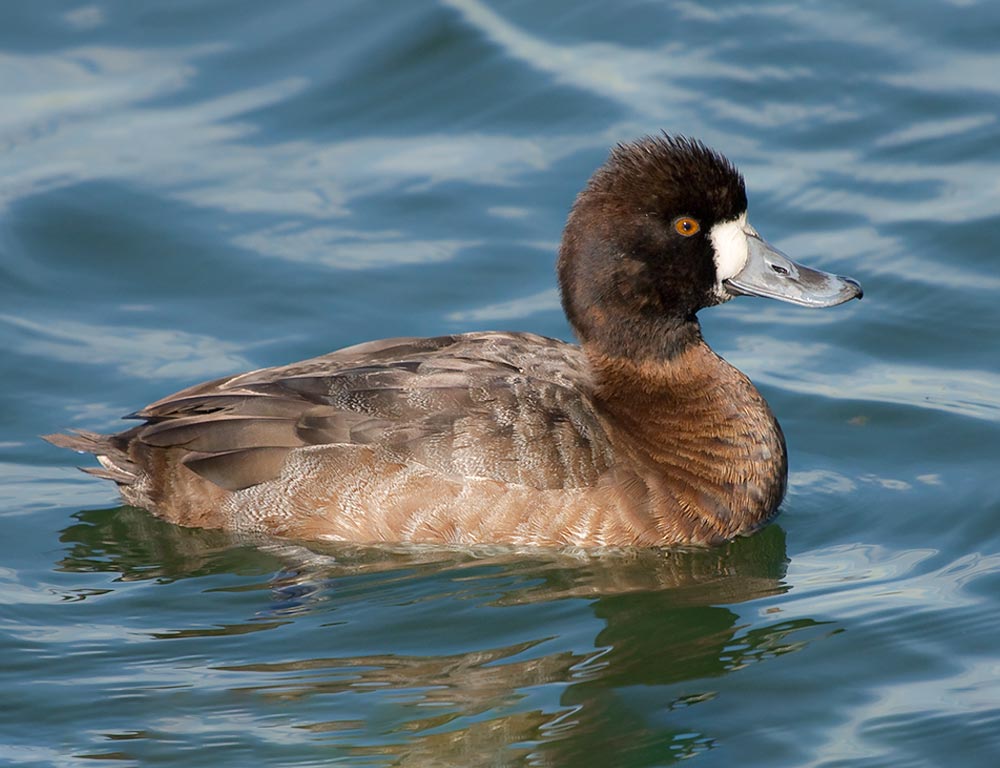
- Scientific name: Aythya affinis
- Population: Stable, common
- Life span: 10-15 years
- Size: 16-19 inches
- Weight: 1.5-2.5 pounds
- Food: Aquatic invertebrates, seeds, plants
- Status: Least Concern (IUCN)
The Lesser Scaup, similar in appearance to the Greater Scaup but smaller in size, is a diving duck commonly found in freshwater lakes and ponds across Maine.
This species is a common sight among waterfowl with its distinctive blue bill and striking plumage.
Lesser Scaups exhibit a dynamic lifestyle, diving for aquatic invertebrates, seeds, and plants in deeper waters. They form large flocks during migration and winter months.
During the breeding season, they form monogamous pairs, and nests are constructed on the ground, hidden in vegetation.
These ducks are strong fliers and undertake significant migrations. Conservation efforts focus on protecting the diverse inland habitats essential for Lesser Scaup breeding and foraging activities.
17. Steller’s Eider

- Scientific name: Polysticta stelleri
- Population: Vulnerable, declining
- Life span: 10-15 years
- Size: 17-21 inches
- Weight: 1.5-2.5 pounds
- Food: Mollusks, crustaceans, invertebrates
- Status: Vulnerable (IUCN)
Steller’s Eider, a sea duck known for its striking black and white plumage, is a rare and declining species found in coastal areas of Maine. With its distinctive appearance and unique feeding habits, this duck is of significant conservation concern.
Steller’s Eiders lead a marine lifestyle, foraging for mollusks, crustaceans, and invertebrates in coastal waters. They form small colonies during the breeding season, and nests are constructed on the ground, often in tundra regions.
Conservation efforts are critical for the survival of Steller’s Eiders, focusing on protecting their vulnerable coastal habitats and addressing threats such as climate change and habitat degradation.
18. King Eider
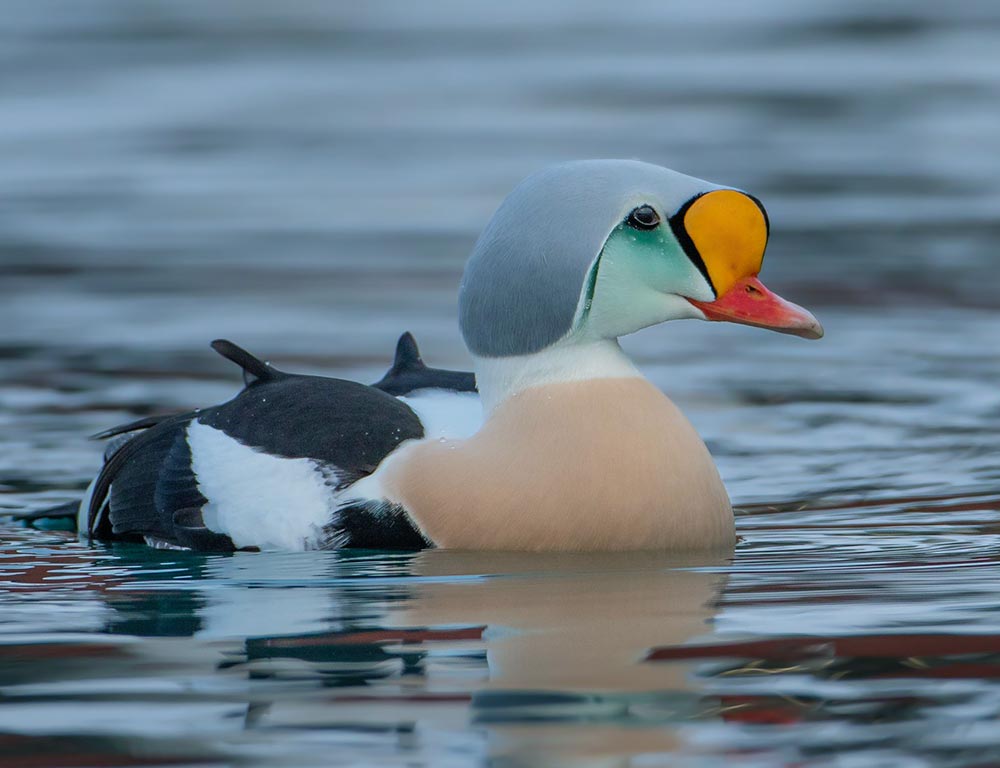
- Scientific name: Somateria spectabilis
- Population: Stable, common
- Life span: 10-15 years
- Size: 20-25 inches
- Weight: 2-4 pounds
- Food: Mollusks, crustaceans, invertebrates
- Status: Least Concern (IUCN)
The King Eider, a large sea duck with colourful and distinctive plumage, is commonly found in Maine’s coastal waters and offshore areas. With its regal appearance and unique feeding habits, this species is a remarkable member of the waterfowl community.
King Eiders lead a marine lifestyle, foraging for mollusks, crustaceans, and invertebrates in cold northern waters. They form colonies during the breeding season, and nests are constructed on the ground, often in tundra regions.
Conservation efforts focus on protecting the diverse coastal and offshore habitats essential for King Eider breeding and foraging activities.
Despite being categorized as Least Concern, continued monitoring is crucial to ensure their populations remain stable amid potential environmental changes.
19. Common Eider
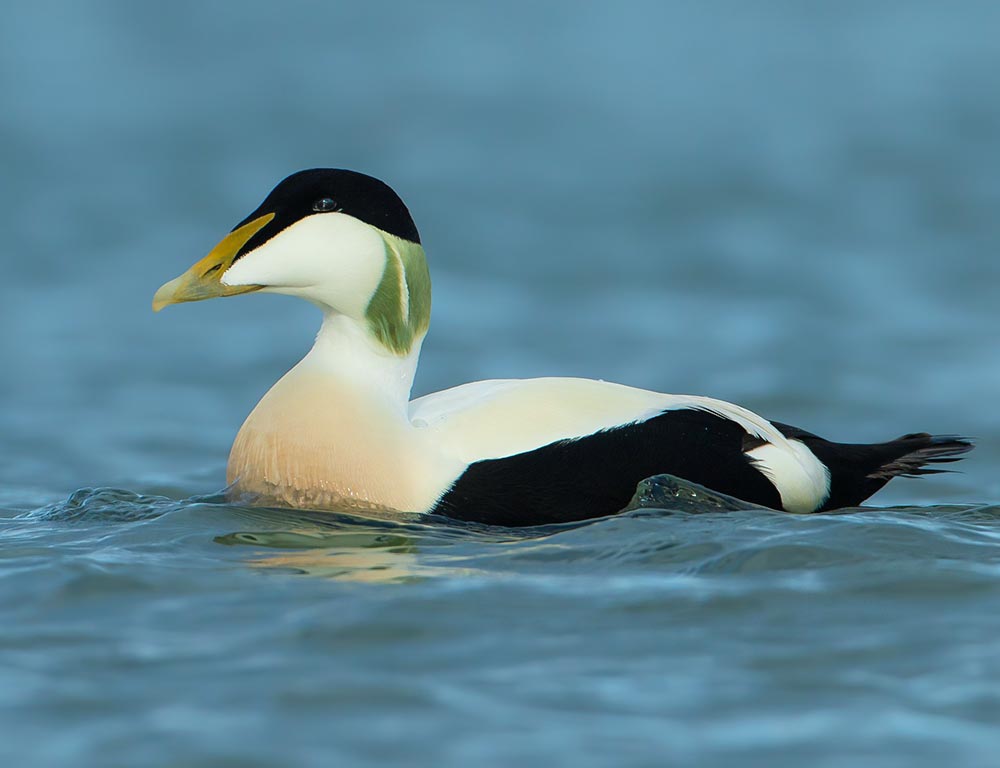
- Scientific name: Somateria mollissima
- Population: Stable, common
- Life span: 10-20 years
- Size: 20-28 inches
- Weight: 3-5 pounds
- Food: Mollusks, crustaceans, invertebrates
- Status: Least Concern (IUCN)
The Common Eider, a large sea duck with distinctive plumage, is commonly found in Maine’s coastal waters and offshore areas. Recognized for its regal appearance and unique nesting habits, this species is a notable member of the waterfowl community.
Common Eiders lead a marine lifestyle, foraging for mollusks, crustaceans, and invertebrates in cold northern waters.
They form large colonies during the breeding season, and nests are constructed on the ground, often in tundra regions. Females line their nests with soft down feathers, which are also used in traditional eiderdown harvesting.
Conservation efforts focus on protecting the diverse coastal and offshore habitats essential for Common Eider breeding and foraging activities.
20. Harlequin Duck
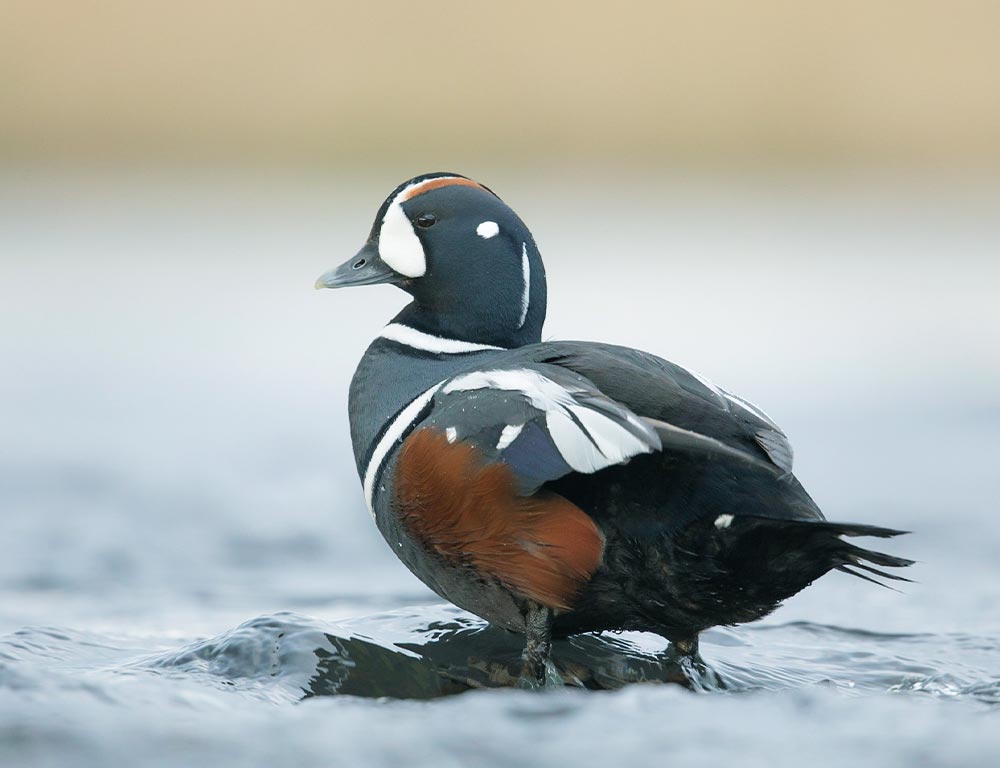
- Scientific name: Histrionicus histrionicus
- Population: Stable, moderate
- Life span: 5-10 years
- Size: 14-20 inches
- Weight: 1-2 pounds
- Food: Aquatic invertebrates, crustaceans, small fish
- Status: Least Concern (IUCN)
The Harlequin Duck, known for its striking and colourful plumage, is a sea duck commonly found in fast-flowing rivers and coastal waters of Maine.
With its unique appearance and agile diving abilities, this species is a captivating member of the waterfowl community.
Harlequin Ducks lead a dynamic lifestyle, often foraging in turbulent waters for aquatic invertebrates, crustaceans, and small fish.
They form monogamous pairs during the breeding season, and nests are constructed on the ground, typically near the water’s edge.
Conservation efforts aim to protect the diverse riverine and coastal habitats essential for Harlequin Duck breeding and foraging activities.
Despite being categorized as Least Concern, monitoring is crucial to address potential threats such as habitat degradation and pollution.
21. Surf Scoter
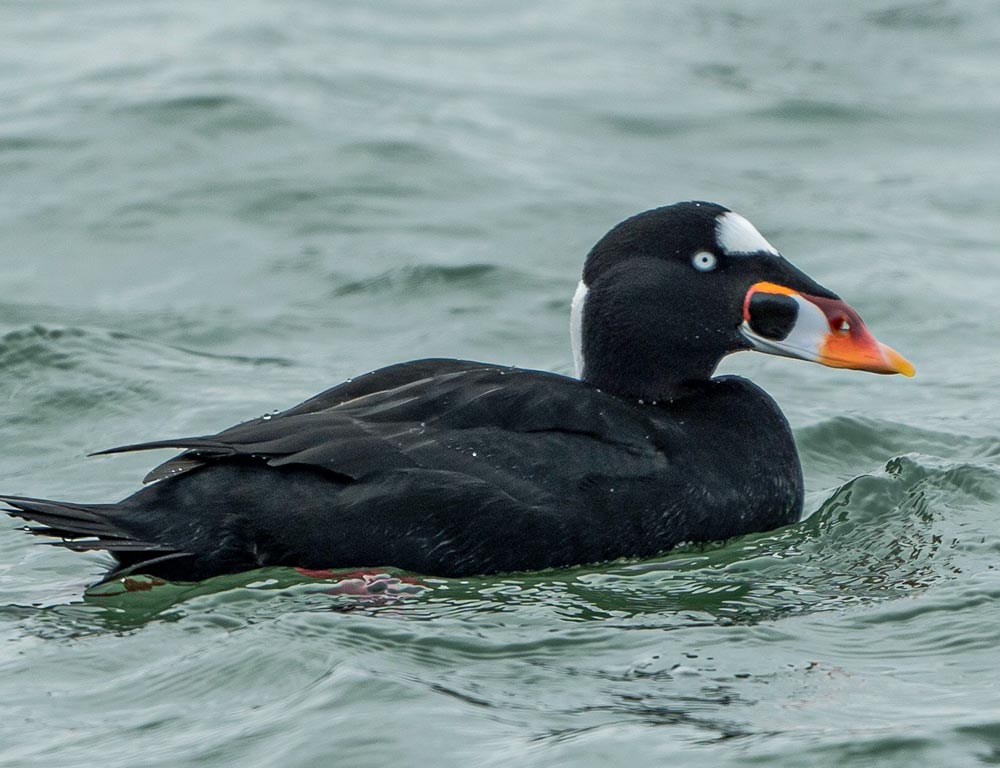
- Scientific name: Melanitta perspicillata
- Population: Stable, moderate
- Life span: 5-10 years
- Size: 19-22 inches
- Weight: 2-3 pounds
- Food: Mollusks, crustaceans, small fish
- Status: Least Concern (IUCN)
The Surf Scoter, recognized for its distinctive multicolored bill, is a sea duck commonly found in Maine’s coastal waters and offshore areas.
With its unique appearance and diving behaviour, this species is an interesting member of the waterfowl community. Surf Scoters lead a marine lifestyle, foraging for mollusks, crustaceans, and small fish in cold northern waters.
They often form large flocks during migration and winter months. During the breeding season, they form monogamous pairs, and nests, typically concealed in vegetation, are constructed on the ground.
Conservation efforts focus on protecting the diverse coastal and offshore habitats essential for Surf Scoter breeding and foraging activities.
Despite being categorized as Least Concern, continuous monitoring is crucial to address potential threats such as oil spills and habitat degradation.
22. White-winged Scoter
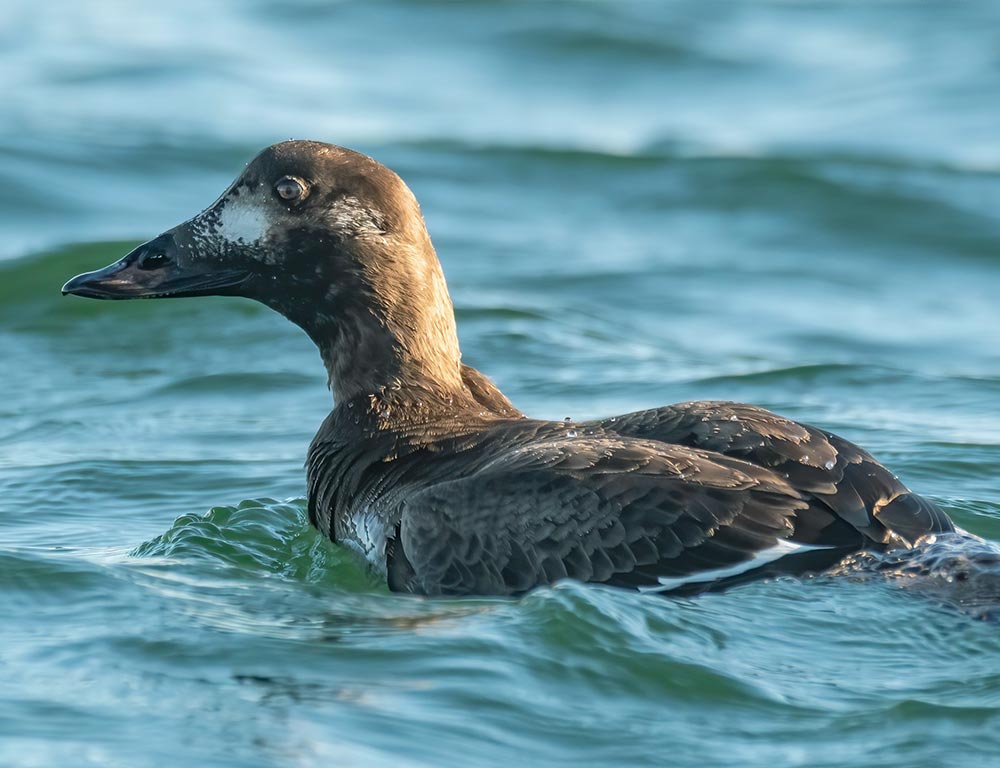
- Scientific name: Melanitta deglandi
- Population: Stable, moderate
- Life span: 10-20 years
- Size: 20-24 inches
- Weight: 2.5-5 pounds
- Food: Mollusks, crustaceans, small fish
- Status: Least Concern (IUCN)
The White-winged Scoter, characterized by its dark plumage and distinctive white patches on the wings, is a sea duck commonly found in Maine’s coastal waters and offshore areas.
With its large size and unique appearance, this species is a notable member of the waterfowl community. White-winged Scoters lead a marine lifestyle, foraging for mollusks, crustaceans, and small fish in cold northern waters.
They often form large flocks during migration and winter months. During the breeding season, they form loose colonies, and nests, typically concealed in vegetation, are constructed on the ground.
Conservation efforts focus on protecting the diverse coastal and offshore habitats essential for White-winged screer breeding and foraging activities.
Despite being categorized as Least Concern, monitoring is crucial to address potential threats such as oil spills and habitat degradation.
23. Black Scoter
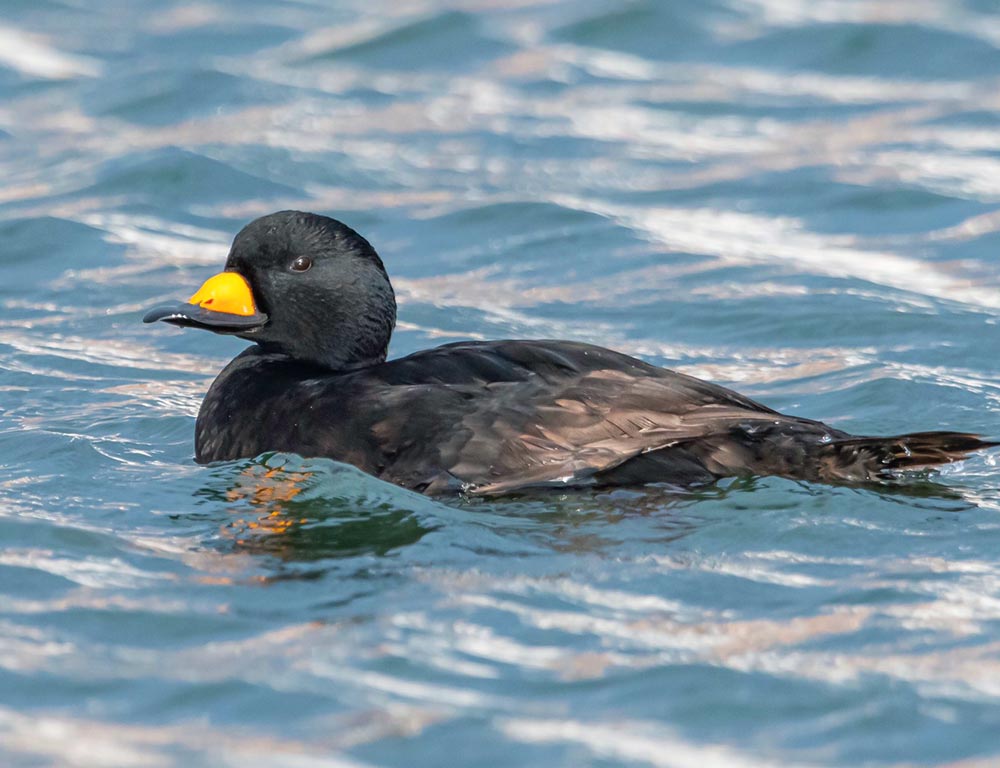
- Scientific name: Melanitta americana
- Population: Stable, moderate
- Life span: 10-20 years
- Size: 19-24 inches
- Weight: 2.5-4 pounds
- Food: Mollusks, crustaceans, small fish
- Status: Least Concern (IUCN)
The Black Scoter, known for its dark plumage and distinctive orange knob on the bill, is a sea duck commonly found in coastal waters and offshore areas of Maine.
With its striking appearance and diving behaviour, this species is a captivating member of the waterfowl community. Black Scoters lead a marine lifestyle, foraging for mollusks, crustaceans, and small fish in cold northern waters.
They often form large flocks during migration and winter months. During the breeding season, they form loose colonies, and nests, typically concealed in vegetation, are constructed on the ground.
Conservation efforts focus on protecting the diverse coastal and offshore habitats essential for Black Scoter breeding and foraging activities.
Despite being categorized as Least Concern, monitoring is crucial to address potential threats such as oil spills and habitat degradation.
24. Long-tailed Duck
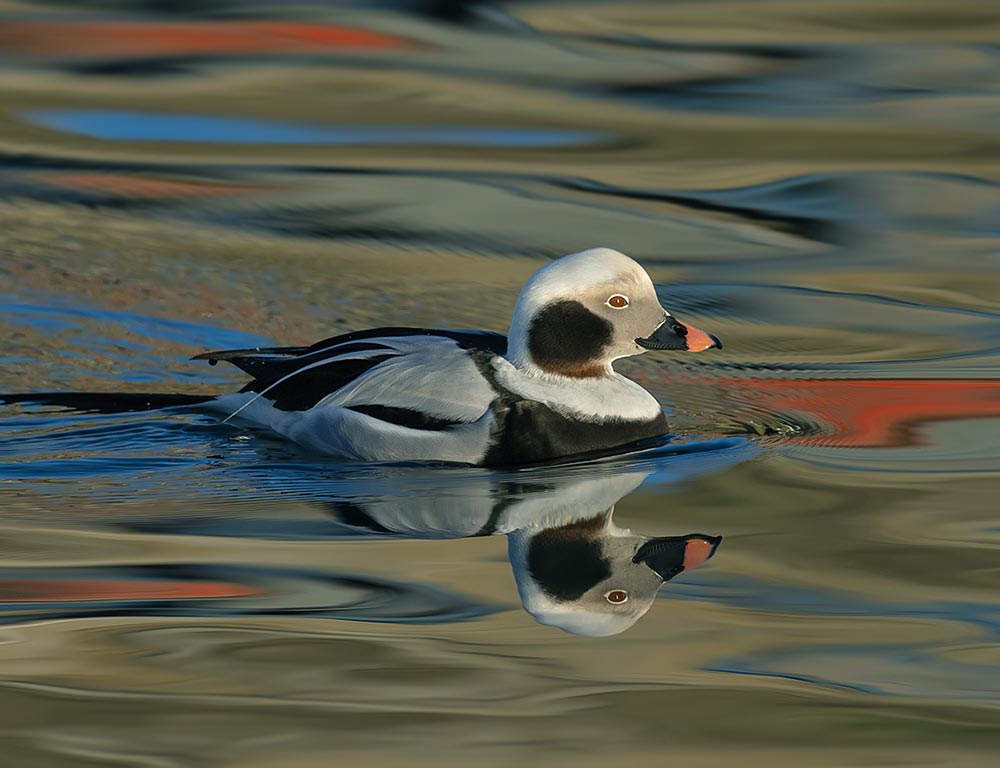
- Scientific name: Clangula hyemalis
- Population: Stable, common
- Life span: 10-20 years
- Size: 16-22 inches
- Weight: 1.5-3 pounds
- Food: Mollusks, crustaceans, small fish
- Status: Least Concern (IUCN)
The Long-tailed Duck, named for its elongated central tail feathers, is a sea duck commonly found in Maine’s coastal waters, estuaries, and freshwater lakes.
With its unique appearance and distinctive vocalizations, this species is a prominent member of the waterfowl community. Long-tailed Ducks lead a versatile lifestyle, foraging for mollusks, crustaceans, and small fish in various aquatic environments.
They often form large flocks during migration and winter months. During the breeding season, they form monogamous pairs, and nests are constructed on the ground, typically near water.
Conservation efforts focus on protecting the diverse coastal and freshwater habitats essential for Long-tailed Duck breeding and foraging activities.
Despite being categorized as Least Concern, continuous monitoring is crucial to address potential threats such as habitat loss and pollution.
Wrapping Up
Maine’s diverse wetlands, lakes, and coastal areas host various duck species, each contributing uniquely to the region’s ecological balance.
From the vibrant Mallard and the striking Tufted Duck to the elusive Steller’s Eider and the versatile Long-tailed Duck, these waterfowl play crucial roles in maintaining healthy ecosystems.
The intricate relationships between these ducks and their habitats underscore the importance of conservation efforts, ensuring the preservation of wetlands and coastal areas crucial for breeding, foraging, and migration.
While many duck populations remain stable, others, such as the vulnerable Steller’s Eider, require heightened attention to address declining numbers and protect their specialized habitats.
A comprehensive conservation, habitat preservation, and monitoring approach is essential to sustain Maine’s diverse duck populations for future generations to appreciate and enjoy.